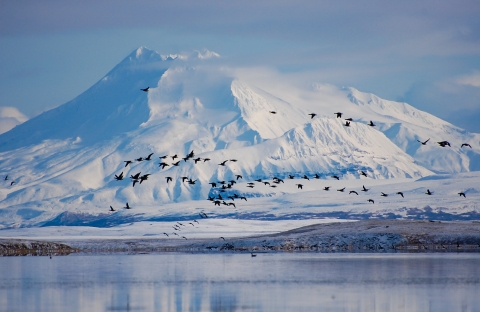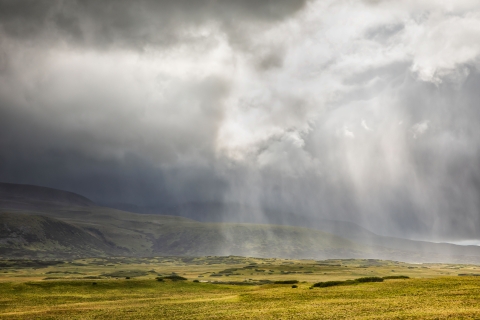About Us
Homeland of the Unangax̂ peoples, Izembek National Wildlife Refuge is at the tip of the Alaska Peninsula between the highly productive waters of the Bering Sea and the Gulf of Alaska. At the heart of a landscape sculpted by volcanism, glaciation, and marine deposition is Izembek Lagoon, one of the world's largest eelgrass beds. The huge lagoon serves as a resting and feeding area for hundreds of thousands of waterfowl. Virtually the entire population of Pacific black brant, tens of thousands of Taverner's Canada goose, and emperor goose inhabit the lagoon each fall. Thousands of threatened Steller's eiders also molt, rest, and feed at Izembek each autumn.
Izembek Lagoon and its associated state-owned tidal lands have been protected by the State of Alaska since 1960 as the Izembek State Game Refuge. Most of the refuge was designated as Wilderness in 1980 under the Alaska National Interest Lands Conservation Act. This diverse wilderness protects a wide variety of fish and wildlife species including coastal brown bears, all five species of salmon, and the Southern Alaska Peninsula Caribou Herd.
In addition to the Lagoon, the most prominent landforms in the refuge include Pavlof Volcano (Pavlof Unit), the heavily-glaciated Shishaldin Volcano (Unimak Island), Frosty Peak and the jagged spires of the Aghileen Pinnacles.
Our Mission
The primary purpose of Izembek National Wildlife Refuge is to to conserve fish and wildlife populations and habitats in their natural diversity including, but not limited to, waterfowl, shorebirds, and other migratory birds; brown bears, Pacific salmon and Dolly Varden char.
Each unit of the National Wildlife Refuge System is established to serve a statutory purpose that targets the conservation of native species dependent on its lands and waters. All activities on those acres are reviewed for compatibility with this statutory purpose. Alaska's Refuges 16 Refuges conserve fish and wildlife populations and habitats in their natural diversity; fulfill international treaty obligations of the United States with respect to fish and wildlife and their habitats; provide opportunities for continued subsistence uses by local residents; support scientific research; and protect water quality and quantity.
Vision
That Izembek National Wildlife Refuge lands will continue to be a pristine habitat, abundant with natural diversity, and serving as a place of rest, rejuvenation, and sustenance for both wildlife and the human spirit. The refuge, spanning mountains, volcanoes, glaciers, and rocky cliffs to lowland tundra, wetlands and eelgrass-filled coastal lagoons, will continue providing a wind-swept pathway for migrant species moving globally, regionally, and locally, a vital link between a national system of refuges and global ecosystems. This will be a place where people develop relationships tied closely to the natural environment, whether for subsistence, recreation or a passion for wildness.
Our History
On December 6, 1960, the 498,000-acre Izembek National Wildlife Range was established, as "a refuge, breeding ground, and management area for all forms of wildlife." These lands were originally a part of the Aleutian Islands National Wildlife Refuge. In 1972, Izembek Lagoon was protected through the Alaska Submerged Lands Act and establishment of Izembek State Game Refuge. With passage of the Alaska National Interest Lands Conservation Act in 1980, 310,000 acres were officially designated as the Izembek National Wildlife Refuge, nearly all of which is the Izembek Wilderness Area. In 1986, Izembek Lagoon was one of the first U.S. sites to be named a Wetland of International Importance.




